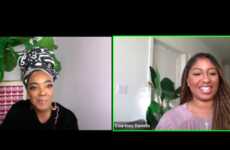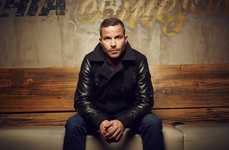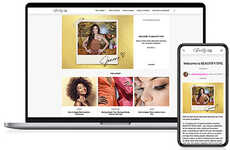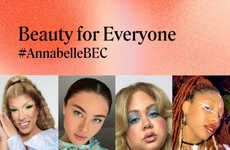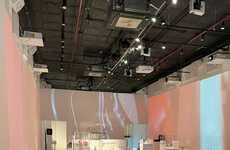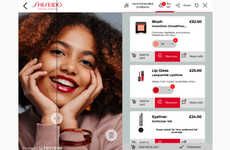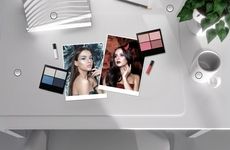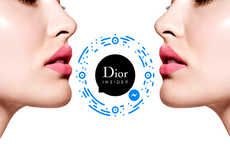
Antonette Bivona, Director of Global Marketing at Almay
Riley von Niessen — March 4, 2017 — Business
References: revlon
Recently, Trend Hunter spoke with Antonette Bivona, currently the Director of Global Marketing for Almay, a cosmetics brand that’s owned by Revlon.
She touched on the importance of putting oneself in the shoes of the consumer, trusting gut instincts, understanding the global market, and much more.
Maybe we could start with you telling us a bit about yourself and your role at Revlon.
I’ve been at Revlon for 25 years now. I started out in marketing and eventually moved to product development after a few years. My background at the Fashion Institute of Technology, where I studied cosmetic marketing, definitely helped with this. In the last couple years I’ve moved back into marketing, which has been a really interesting transition for me considering that I’ve been in such a creative role with product development for so long.
At Revlon I’m a jack of all trades right now though, so I work on developing the products, the formulas and the concepts while working on the marketing side as well. Currently I’m on the Almay brand, but I’ve worked across all brands in the organization during my time here.
How does your team generate great ideas? Do you have certain rituals to make creativity happen?
We’re constantly looking at current trends both inside and outside of the industry, we find that great influence comes from all over. For example, we’re always looking at what’s happening in the food and beverage industry, or even in the automotive and art supplies industries.
It’s really important to always be aware of what your competition is doing and to reassess your portfolio to see if there’s any gaps that you can fill. We weigh this with the needs of our consumers of course too, which really helps us to come up with product concepts.
I find just getting outside the office helps with creativity. This could mean just going for a walk, perusing the stores to experience the market from a another perspective and even just seeing how consumers interact with the brand. We try to break out of our day-to-day routine at Revlon to help with this, because it’s a key step to getting ideas flowing.
What are some barriers to innovation? How do you get around them?
Sometimes the product you bring to market isn’t exactly what you envisioned, but you do your best within your confines to really deliver on something that’s new and different for the consumer. To get around barriers you have to be flexible while standing your ground on what you believe the true dynamics are of what you’re trying to push forward. Sometimes you have to make compromises -- maybe in the package, or somewhat in the formula, but there’s certain things you just can’t give on if you really want to deliver on innovation.
Previously, you mentioned that you’re a jack of all trades in a sense at Revlon. Do you think that the versatility of your role helps you to overcome barriers?
I think so, it really does help you to look differently at products, especially as someone who comes from such a creative background. I think you’re able to bring something new to the table when you’re involved in so many different areas.
How do you identify trends? What resources does your team use to spot trends and insights?
You have to constantly be looking everywhere, I don’t think there’s just one source that you can use for identifying trends, especially today when we’re always looking at social media. We look at what’s happening at award shows and the red carpet to get a better understanding of different influences as well. Additionally, we use trend forecasting researchers, as well as packaging and raw material suppliers which we find helpful.
Looking at global markets is extremely important. The biggest trends in cosmetics today are coming out of Korea. You can identify trends in so many different places that it’s hard to pinpoint just a few resources because inspiration can come from almost anywhere. I think it’s key to take a nontraditional approach to stay ahead in trends, while also using more traditional resources for validation in a sense.
Do you have specific rituals for resetting to be creative?
We do brainstorming sessions outside of the office where we bring in outside people to get into a different mindset and inspire new ideas. We try to switch it up as much as we can just to get a different flow of ideas going. I find that it’s really interesting to look at the perspectives of people from different industries. This helps us to think in different ways while still ensuring that we stay on target.
Has there ever been an instance where another industry has influenced an innovation at your company?
Definitely. We look at the food industry a lot and we attend the Fancy Food Show to get a better idea of how the industry in changing. We even look at performance beverages, ingestibles, and athletic wear. The technology industry is also a big one.
Today the sky's the limit in terms of innovation. Even if something that an industry is doing can’t really be applied to cosmetics, the steps that they're taking are really inspirational and make you stop and think how you can infuse different elements that you normally might not.
What are some examples of things you can do to create a culture of innovation?
I think it’s important to get together and let ideas flow freely so that you can build on another person’s thoughts and just get thinking differently. It’s all about taking the time to just share ideas across the different brands, so that you can build on different projects and elevate the end result. Sometimes having a new perspective thrown in can help someone who’s stuck in a train of thought to totally open up and make some improvements.
What do you think your industry will look like in 10 years?
I think technology is going to take it to the next level. What I find the most interesting as someone who’s been in the industry for so many years is the influence of bloggers and other social media moguls. The roles of these influencers are changing and they’re becoming more involved in development, so I think they’ve definitely made a huge impact in the industry and I look forward to seeing how that progresses.
What’s the most unconventional thing you have done to get creative inspiration?
For me, just exploring New York itself can be a great source of inspiration. I love to see the different ways that people use their bodies as a canvas to convey a unique type of self-expression. It’s interesting to see how far people will push the limits and break out of conventional beauty looks.
Have you identified patterns between recent and historical trends in your industry?
The cosmetic industry is definitely cyclical, but trends never come back in exactly the same way. Being in the industry for over 20 years, I’ve seen trends come and go, but every time they come back it's in a different way to meet new consumer and lifestyle needs. This can be the way the product is delivered via the package, the texture of the formula, or even the way that you’re speaking about it to make it relevant for today.
By what means does Revlon explore firsthand consumer experiences?
We put ourselves in the shoes of the consumer all the time. It’s vital to make sure you do this, especially in the cosmetics industry because a big part of success is getting a product right in the market. You have to get out there and see how your brand looks, as well as what your competitors are doing, so that you can see what’s working, what’s not, and adapt from there.
She touched on the importance of putting oneself in the shoes of the consumer, trusting gut instincts, understanding the global market, and much more.
Maybe we could start with you telling us a bit about yourself and your role at Revlon.
I’ve been at Revlon for 25 years now. I started out in marketing and eventually moved to product development after a few years. My background at the Fashion Institute of Technology, where I studied cosmetic marketing, definitely helped with this. In the last couple years I’ve moved back into marketing, which has been a really interesting transition for me considering that I’ve been in such a creative role with product development for so long.
At Revlon I’m a jack of all trades right now though, so I work on developing the products, the formulas and the concepts while working on the marketing side as well. Currently I’m on the Almay brand, but I’ve worked across all brands in the organization during my time here.
How does your team generate great ideas? Do you have certain rituals to make creativity happen?
We’re constantly looking at current trends both inside and outside of the industry, we find that great influence comes from all over. For example, we’re always looking at what’s happening in the food and beverage industry, or even in the automotive and art supplies industries.
It’s really important to always be aware of what your competition is doing and to reassess your portfolio to see if there’s any gaps that you can fill. We weigh this with the needs of our consumers of course too, which really helps us to come up with product concepts.
I find just getting outside the office helps with creativity. This could mean just going for a walk, perusing the stores to experience the market from a another perspective and even just seeing how consumers interact with the brand. We try to break out of our day-to-day routine at Revlon to help with this, because it’s a key step to getting ideas flowing.
What are some barriers to innovation? How do you get around them?
Sometimes the product you bring to market isn’t exactly what you envisioned, but you do your best within your confines to really deliver on something that’s new and different for the consumer. To get around barriers you have to be flexible while standing your ground on what you believe the true dynamics are of what you’re trying to push forward. Sometimes you have to make compromises -- maybe in the package, or somewhat in the formula, but there’s certain things you just can’t give on if you really want to deliver on innovation.
Previously, you mentioned that you’re a jack of all trades in a sense at Revlon. Do you think that the versatility of your role helps you to overcome barriers?
I think so, it really does help you to look differently at products, especially as someone who comes from such a creative background. I think you’re able to bring something new to the table when you’re involved in so many different areas.
How do you identify trends? What resources does your team use to spot trends and insights?
You have to constantly be looking everywhere, I don’t think there’s just one source that you can use for identifying trends, especially today when we’re always looking at social media. We look at what’s happening at award shows and the red carpet to get a better understanding of different influences as well. Additionally, we use trend forecasting researchers, as well as packaging and raw material suppliers which we find helpful.
Looking at global markets is extremely important. The biggest trends in cosmetics today are coming out of Korea. You can identify trends in so many different places that it’s hard to pinpoint just a few resources because inspiration can come from almost anywhere. I think it’s key to take a nontraditional approach to stay ahead in trends, while also using more traditional resources for validation in a sense.
Do you have specific rituals for resetting to be creative?
We do brainstorming sessions outside of the office where we bring in outside people to get into a different mindset and inspire new ideas. We try to switch it up as much as we can just to get a different flow of ideas going. I find that it’s really interesting to look at the perspectives of people from different industries. This helps us to think in different ways while still ensuring that we stay on target.
Has there ever been an instance where another industry has influenced an innovation at your company?
Definitely. We look at the food industry a lot and we attend the Fancy Food Show to get a better idea of how the industry in changing. We even look at performance beverages, ingestibles, and athletic wear. The technology industry is also a big one.
Today the sky's the limit in terms of innovation. Even if something that an industry is doing can’t really be applied to cosmetics, the steps that they're taking are really inspirational and make you stop and think how you can infuse different elements that you normally might not.
What are some examples of things you can do to create a culture of innovation?
I think it’s important to get together and let ideas flow freely so that you can build on another person’s thoughts and just get thinking differently. It’s all about taking the time to just share ideas across the different brands, so that you can build on different projects and elevate the end result. Sometimes having a new perspective thrown in can help someone who’s stuck in a train of thought to totally open up and make some improvements.
What do you think your industry will look like in 10 years?
I think technology is going to take it to the next level. What I find the most interesting as someone who’s been in the industry for so many years is the influence of bloggers and other social media moguls. The roles of these influencers are changing and they’re becoming more involved in development, so I think they’ve definitely made a huge impact in the industry and I look forward to seeing how that progresses.
What’s the most unconventional thing you have done to get creative inspiration?
For me, just exploring New York itself can be a great source of inspiration. I love to see the different ways that people use their bodies as a canvas to convey a unique type of self-expression. It’s interesting to see how far people will push the limits and break out of conventional beauty looks.
Have you identified patterns between recent and historical trends in your industry?
The cosmetic industry is definitely cyclical, but trends never come back in exactly the same way. Being in the industry for over 20 years, I’ve seen trends come and go, but every time they come back it's in a different way to meet new consumer and lifestyle needs. This can be the way the product is delivered via the package, the texture of the formula, or even the way that you’re speaking about it to make it relevant for today.
By what means does Revlon explore firsthand consumer experiences?
We put ourselves in the shoes of the consumer all the time. It’s vital to make sure you do this, especially in the cosmetics industry because a big part of success is getting a product right in the market. You have to get out there and see how your brand looks, as well as what your competitors are doing, so that you can see what’s working, what’s not, and adapt from there.
Trend Themes
1. Looking Beyond the Industry - Exploring trends and inspiration from other industries, such as food and beverage, automotive, and art supplies, can lead to disruptive innovation opportunities in the cosmetics industry.
2. Global Market Insights - Understanding and incorporating trends from global markets, particularly in countries like Korea, can drive innovative product development and stay ahead in the cosmetics industry.
3. Nontraditional Trend Spotting - Taking a nontraditional approach to trend spotting, including social media, award shows, and trend forecasting researchers, helps uncover new, inspirational ideas to fuel innovation in the cosmetics industry.
Industry Implications
1. Food and Beverage Industry - Innovative practices and trends from the food and beverage industry can be applied to cosmetics products and packaging, leading to disruptive innovation opportunities.
2. Automotive Industry - Exploring trends in the automotive industry can inspire unique product concepts and design elements for the cosmetics industry, creating disruptive innovation opportunities.
3. Art Supplies Industry - Drawing inspiration from the art supplies industry can spark creative packaging designs, formula textures, and marketing strategies within the cosmetics industry, driving disruptive innovation.
2.8
Score
Popularity
Activity
Freshness


